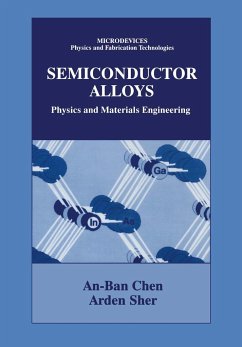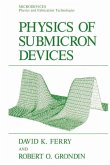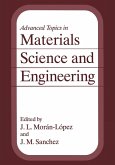- Gebundenes Buch
- Merkliste
- Auf die Merkliste
- Bewerten Bewerten
- Teilen
- Produkt teilen
- Produkterinnerung
- Produkterinnerung
In the first comprehensive treatment of these technologically important materials, the authors provide theories linking the properties of semiconductor alloys to their constituent compounds. Topics include crystal structures, bonding, elastic properties, phase diagrams, band structures, transport, ab-initio theories, and semi-empirical theories. Each chapter includes extensive tables and figures as well as problem sets.
Andere Kunden interessierten sich auch für
![Electron Beam Testing Technology Electron Beam Testing Technology]() ThongElectron Beam Testing Technology116,99 €
ThongElectron Beam Testing Technology116,99 €![Electron Transport in Quantum Dots Electron Transport in Quantum Dots]() Jonathan P. Bird (Hrsg.)Electron Transport in Quantum Dots239,99 €
Jonathan P. Bird (Hrsg.)Electron Transport in Quantum Dots239,99 €![Introduction to Focused Ion Beams Introduction to Focused Ion Beams]() Introduction to Focused Ion Beams154,99 €
Introduction to Focused Ion Beams154,99 €![Physics of Submicron Devices Physics of Submicron Devices]() David K. FerryPhysics of Submicron Devices41,99 €
David K. FerryPhysics of Submicron Devices41,99 €![Semimagnetic Semiconductors and Diluted Magnetic Semiconductors Semimagnetic Semiconductors and Diluted Magnetic Semiconductors]() M. Averous (ed.) / M. BalkanskiSemimagnetic Semiconductors and Diluted Magnetic Semiconductors62,99 €
M. Averous (ed.) / M. BalkanskiSemimagnetic Semiconductors and Diluted Magnetic Semiconductors62,99 €![Advanced Topics in Materials Science and Engineering Advanced Topics in Materials Science and Engineering]() J M SanchezAdvanced Topics in Materials Science and Engineering62,99 €
J M SanchezAdvanced Topics in Materials Science and Engineering62,99 €
In the first comprehensive treatment of these technologically important materials, the authors provide theories linking the properties of semiconductor alloys to their constituent compounds. Topics include crystal structures, bonding, elastic properties, phase diagrams, band structures, transport, ab-initio theories, and semi-empirical theories. Each chapter includes extensive tables and figures as well as problem sets.
Produktdetails
- Produktdetails
- Microdevices .
- Verlag: Springer, Berlin
- 1995.
- Seitenzahl: 364
- Erscheinungstermin: 30. November 1995
- Englisch
- Gewicht: 850g
- ISBN-13: 9780306450525
- ISBN-10: 0306450526
- Artikelnr.: 27645209
- Herstellerkennzeichnung
- Libri GmbH
- Europaallee 1
- 36244 Bad Hersfeld
- gpsr@libri.de
- Microdevices .
- Verlag: Springer, Berlin
- 1995.
- Seitenzahl: 364
- Erscheinungstermin: 30. November 1995
- Englisch
- Gewicht: 850g
- ISBN-13: 9780306450525
- ISBN-10: 0306450526
- Artikelnr.: 27645209
- Herstellerkennzeichnung
- Libri GmbH
- Europaallee 1
- 36244 Bad Hersfeld
- gpsr@libri.de
1. Crystal Structures.- 1.1. Diamond, Zinc Blende, and Wurtzite Structures.- 1.2. Bulk Alloys.- 1.3. Alloy Structure Determined by EXAFS.- 1.4. Long-Range Ordered Semiconductor Alloys.- 1.4.1. ABC2 Structures.- 1.4.2. Bond Lengths.- 1.5. Concluding Remarks.- References.- 2. Bonding in Ordered Structures.- 2.1. Cohesive Energy in the Born Oppenheimer Adiabatic Approximation.- 2.2. Density Functional Theory.- 2.3. Bonds and Bands from Local Density Functional Theory.- 2.4. Tight-Binding Approach.- 2.5. The Bond-Orbital Model.- 2.6. Polarity and Ionicity.- 2.7. Excess Energies of Ordered Alloys.- 2.8. Concluding Remarks.- References.- 3. Elasticity.- 3.1. Definitions and Analysis.- 3.2. Ab Initio Calculations.- 3.3. Valence-Force-Field Model.- 3.3.1. Diamond Structure.- 3.3.2. Zinc Blende Structure and Coulomb Force.- 3.4. Exact Tight-Binding Calculation.- 3.5. Analytical Expressions in the Bond-Orbital Model.- 3.6. Quantitative Tight-Binding Model.- 3.6.1. Full-Band-Structure Calculation.- 3.6.2. Quantitative Extended Bond-Orbital Model.- 3.7. Elasticity in Alloys.- 3.7.1. Ordered Alloys.- 3.7.2. Disordered Alloys.- 3.8. Concluding Remarks.- References.- 4. Alloy Statistics and Phase Diagrams.- 4.1. Mixing Free Energy, Miscibility Gap, and Order-Disorder Transitions.- 4.2. Analytical Models.- 4.2.1. Ideal-Solution Model.- 4.2.2. Zeroth Approximation.- 4.2.3. First Approximation The Quasi-Chemical Approximation.- 4.3. Phase Diagram: Common Tangent Line and Activity Coefficient.- 4.4. Vieland s Method and Binary Liquidus.- 4.5. Ternary Phase Diagrams.- 4.6. Phase Diagram Data and Simple Mixing Enthalpy Models.- 4.7. Generalized Quasi-Chemical Theory.- 4.8. Internal Strain and Cluster Energies.- 4.9. Sixteen-Bond Microclusters.- 4.10. Cluster Variational Method.- 4.11. Ab Initio Calculations.- 4.12. Concluding Remarks.- References.- Appendix 4A: Analytical Formulas of GQCA.- Appendix 4B: Critical Temperature in GQCA.- Appendix 4C: GQCA at Low Temperature.- 5. Band Structure Theory.- 5.1. Formation of Energy Bands.- 5.2. LCAO and the Empirical Tight-Binding Method.- 5.3. Plane-Wave Method and Empirical Pseudopotentials.- 5.4. Band Gaps and Effective Masses.- 5.5. Band Structure of Semiconductor Alloys: Problems and Applications.- 5.6. Green Function and Spectral Density of States.- 5.7. Perturbation Theory and Bowing of Fundamental Gaps.- 5.8. Multiple Scattering Theory and the Coherent Potential Approximation.- 5.9. A Single-Band Alloy Model.- 5.10. Molecular CPA for Zinc Blende Alloys.- 5.11. Effects of Diagonal and Off-Diagonal Disorder on Band-Edge Properties.- 5.12. Concluding Remarks.- References.- 6. Transport.- 6.1. Master and Boltzmann Equations.- 6.1.1. Master Equation for a Supersystem.- 6.1.2. Master Equation for a System in a Heat Bath.- 6.1.3. Single-Particle States.- 6.1.4. The Boltzmann Equation.- 6.2. Electron Phonon Interaction and Single-Particle Master Equation.- 6.3. Low-Field Transport for Nondegenerate Electrons in Collision Time Approximations.- 6.4. Mobilities in Alloys: Example, SixGe1-x.- 6.5. Hot-Electron v E Characteristics: Comparison of Materials Merits.- 6.5.1. Example: In1-xGaxAs.- 6.5.2. Merits of Other Alloys Compared with GaAs.- 6.6. Scattering Mechanisms.- 6.6.1. Ionized Impurity Scattering.- 6.6.2. Bare Electron Phonon Interaction.- 6.6.3. Polar Optical Phonon Scattering.- 6.6.4. Alloy Scattering.- 6.6.5. Electron Electron Scattering.- 6.7. Expansion Solution of the Boltzmann Equation.- 6.8. Near-Ballistic Transport.- 6.9. Intervalley Scattering.- 6.10. Narrow-Gap Materials.- 6.11. Concluding Remarks.- References.- 7. Band Structures of Selected Semiconductors and Their Alloys.- 7.1. Hybrid Pseudopotential and Tight-Binding Model (HPT).- 7.2. Band Structures and Hamiltonian Parameters for III V Constituent Compounds.- 7.2.1. A1P.- 7.2.2. A1As.- 7.2.3. A1Sb.- 7.2.4. GaP.- 7.2.5. GaAs.- 7.2.6. GaSb.- 7.2.7. InP.- 7.2.8. InAs.- 7.2.9. InSb.- 7.3. The HPT Model Applied to III V Pseudobinary Alloys.
1. Crystal Structures.- 1.1. Diamond, Zinc Blende, and Wurtzite Structures.- 1.2. Bulk Alloys.- 1.3. Alloy Structure Determined by EXAFS.- 1.4. Long-Range Ordered Semiconductor Alloys.- 1.4.1. ABC2 Structures.- 1.4.2. Bond Lengths.- 1.5. Concluding Remarks.- References.- 2. Bonding in Ordered Structures.- 2.1. Cohesive Energy in the Born Oppenheimer Adiabatic Approximation.- 2.2. Density Functional Theory.- 2.3. Bonds and Bands from Local Density Functional Theory.- 2.4. Tight-Binding Approach.- 2.5. The Bond-Orbital Model.- 2.6. Polarity and Ionicity.- 2.7. Excess Energies of Ordered Alloys.- 2.8. Concluding Remarks.- References.- 3. Elasticity.- 3.1. Definitions and Analysis.- 3.2. Ab Initio Calculations.- 3.3. Valence-Force-Field Model.- 3.3.1. Diamond Structure.- 3.3.2. Zinc Blende Structure and Coulomb Force.- 3.4. Exact Tight-Binding Calculation.- 3.5. Analytical Expressions in the Bond-Orbital Model.- 3.6. Quantitative Tight-Binding Model.- 3.6.1. Full-Band-Structure Calculation.- 3.6.2. Quantitative Extended Bond-Orbital Model.- 3.7. Elasticity in Alloys.- 3.7.1. Ordered Alloys.- 3.7.2. Disordered Alloys.- 3.8. Concluding Remarks.- References.- 4. Alloy Statistics and Phase Diagrams.- 4.1. Mixing Free Energy, Miscibility Gap, and Order-Disorder Transitions.- 4.2. Analytical Models.- 4.2.1. Ideal-Solution Model.- 4.2.2. Zeroth Approximation.- 4.2.3. First Approximation The Quasi-Chemical Approximation.- 4.3. Phase Diagram: Common Tangent Line and Activity Coefficient.- 4.4. Vieland s Method and Binary Liquidus.- 4.5. Ternary Phase Diagrams.- 4.6. Phase Diagram Data and Simple Mixing Enthalpy Models.- 4.7. Generalized Quasi-Chemical Theory.- 4.8. Internal Strain and Cluster Energies.- 4.9. Sixteen-Bond Microclusters.- 4.10. Cluster Variational Method.- 4.11. Ab Initio Calculations.- 4.12. Concluding Remarks.- References.- Appendix 4A: Analytical Formulas of GQCA.- Appendix 4B: Critical Temperature in GQCA.- Appendix 4C: GQCA at Low Temperature.- 5. Band Structure Theory.- 5.1. Formation of Energy Bands.- 5.2. LCAO and the Empirical Tight-Binding Method.- 5.3. Plane-Wave Method and Empirical Pseudopotentials.- 5.4. Band Gaps and Effective Masses.- 5.5. Band Structure of Semiconductor Alloys: Problems and Applications.- 5.6. Green Function and Spectral Density of States.- 5.7. Perturbation Theory and Bowing of Fundamental Gaps.- 5.8. Multiple Scattering Theory and the Coherent Potential Approximation.- 5.9. A Single-Band Alloy Model.- 5.10. Molecular CPA for Zinc Blende Alloys.- 5.11. Effects of Diagonal and Off-Diagonal Disorder on Band-Edge Properties.- 5.12. Concluding Remarks.- References.- 6. Transport.- 6.1. Master and Boltzmann Equations.- 6.1.1. Master Equation for a Supersystem.- 6.1.2. Master Equation for a System in a Heat Bath.- 6.1.3. Single-Particle States.- 6.1.4. The Boltzmann Equation.- 6.2. Electron Phonon Interaction and Single-Particle Master Equation.- 6.3. Low-Field Transport for Nondegenerate Electrons in Collision Time Approximations.- 6.4. Mobilities in Alloys: Example, SixGe1-x.- 6.5. Hot-Electron v E Characteristics: Comparison of Materials Merits.- 6.5.1. Example: In1-xGaxAs.- 6.5.2. Merits of Other Alloys Compared with GaAs.- 6.6. Scattering Mechanisms.- 6.6.1. Ionized Impurity Scattering.- 6.6.2. Bare Electron Phonon Interaction.- 6.6.3. Polar Optical Phonon Scattering.- 6.6.4. Alloy Scattering.- 6.6.5. Electron Electron Scattering.- 6.7. Expansion Solution of the Boltzmann Equation.- 6.8. Near-Ballistic Transport.- 6.9. Intervalley Scattering.- 6.10. Narrow-Gap Materials.- 6.11. Concluding Remarks.- References.- 7. Band Structures of Selected Semiconductors and Their Alloys.- 7.1. Hybrid Pseudopotential and Tight-Binding Model (HPT).- 7.2. Band Structures and Hamiltonian Parameters for III V Constituent Compounds.- 7.2.1. A1P.- 7.2.2. A1As.- 7.2.3. A1Sb.- 7.2.4. GaP.- 7.2.5. GaAs.- 7.2.6. GaSb.- 7.2.7. InP.- 7.2.8. InAs.- 7.2.9. InSb.- 7.3. The HPT Model Applied to III V Pseudobinary Alloys.








